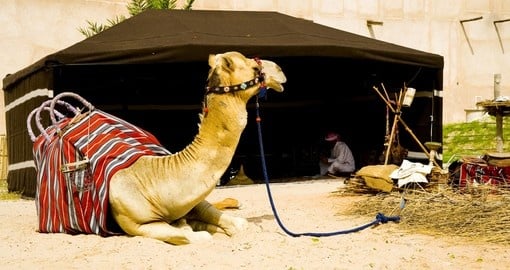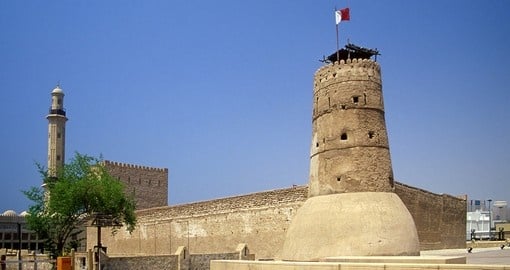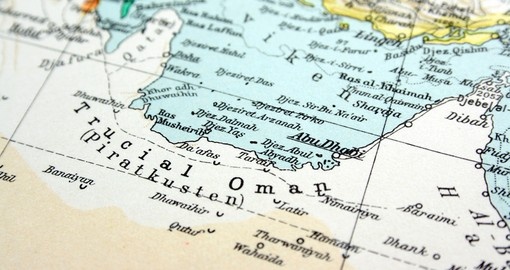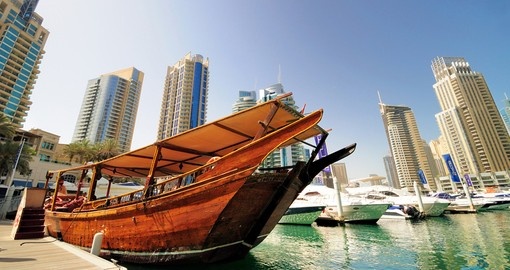United Arab Emirates History
Although the United Arab Emirates is known primarily for its modern buildings, people were actually settled in the area as early as the Neolithic Period around 5,000 BC. Trade relations were established very early on, especially with civilizations to the north. Around 3,000 BC, copper trading had a major impact on the region, allowing for even more widespread contact.
By the first century AD, trading networks were established with Syria and southern Iraq. Pearling operations that had been set up for millennia began to thrive and merchants from as far away as China were interested in the Emirates. The Greeks and Persians had cultural impacts on the region with the Persian Sassanid Empire controlling the area until 630 AD when Islam arrived.
Contact with Europe came in the form of the Portuguese in 1498. By 1515, they had occupied Julfar and set about conquering the Arabian Peninsula. Britain became interested in the region and was eventually successful in gaining the upper hand. While international interests peaked abroad, two powers were beginning to establish themselves locally. Inland, the Bani Yas began to build up Abu Dhabi which had become an important trading centre, while on the coast, the Qawasim developed a strong naval presence that threatened the British in the 19th century.
The Qawasim were brought into conflict with the British, launching raids on ships. The British retaliated with attacks in 1805, 1809 and 1811. By 1820, many Qawasim ships were destroyed and a general Treaty of Peace was imposed. The Treaty of Maritime Perpetuity was established in 1853, and the region became known as the Trucial Coast. The Sheikhs of each tribal confederation signed agreements which stated that they would not have dealings with any other nation than the UK, and in return, the British would protect the region from invasion.
The First World War had a significant impact on the pearling industry, and so too did the Japanese discovery of cultured pearl. As a result of the subsequent demise of the pearl industry, as well as the economic depression of the 1920s and 1930s, the economy was facing a steady decline. The Sheikhs of Abu Dhabi, Dubai and Sharjah discussed the possibility of oil exploration in the area, and in the 1930s, the first oil company teams conducted geological surveys. The first cargo of oil left Abu Dhabi in 1962, followed by Dubai in 1969.
In February 1968, a plan was formulated that would establish a federation that included Bahrain, Qatar and the Trucial Coast. However, plans changed and on 2 December 1971, six of the emirates (Umm al-Quwain, Dubai, Sharjah, Ajman, Fuhirah and Abu Dhabi) united to form one country. The following year, Ras al-Khaimah joined and the United Arab Emirates came into being.
Within each emirate, a sheikh maintains control over natural resources and is also in charge of regulating commerce with rules and policies. Despite this, since coming together, the emirates have formed a distinct national identity. Many critics said that the UAE wouldn’t last due to the political turmoil in regions surrounding the country, as well as the differences between the seven emirates themselves. Yet, the UAE remains the only united Arab state in the region.
In the forty years since independence, the United Arab Emirates has transformed itself from tribes relying on farming and fishing to one of the wealthiest and most exciting nations in the world. The UAE is a combination of old and new, east and west. The financial crisis of recent years has crippled many countries; however, the UAE has managed to survive with the more fortunate emirates helping to bail out their less fortunate counterparts.
The country has become an important destination for business travelers and holidaymakers alike. It seems as if the whole world has an eye on the UAE as it continues to grow, literally reaching new heights with the tallest building in the world.
United Arab Emirates Travel Information
At Goway we believe that a well-informed traveller is a safer traveller. With this in mind, we have compiled an easy-to-navigate travel information section dedicated to United Arab Emirates (UAE).
Learn about the history and culture of UAE, the must-try food and drink, and what to pack in your suitcase. Read about UAE's nature and wildlife, weather and geography, along with 'Country Quickfacts' compiled by our travel experts. Our globetrotting tips, as well as our visa and health information, will help ensure you're properly prepared for a safe and enjoyable trip. The only way you could possibly learn more is by embarking on your journey and discovering UAE for yourself. Start exploring… book one of our United Arab Emirates tours today!
Extend Your Trip
After your United Arab Emirates tours, why not consider one of Goway's Europe Tours
Book your UAE tour with Goway!
 AfricaExperts is the exclusive division of Goway that specializes in planning and organizing United Arab Emirates tours and experiences. Choose from a simple city stopover, a stay of distinction, a locally escorted tour, an independent travel module and more. We want to be your first choice when next you go globetrotting to United Arab Emirates.
AfricaExperts is the exclusive division of Goway that specializes in planning and organizing United Arab Emirates tours and experiences. Choose from a simple city stopover, a stay of distinction, a locally escorted tour, an independent travel module and more. We want to be your first choice when next you go globetrotting to United Arab Emirates.
Get a Trip Quote Order a Brochure




















